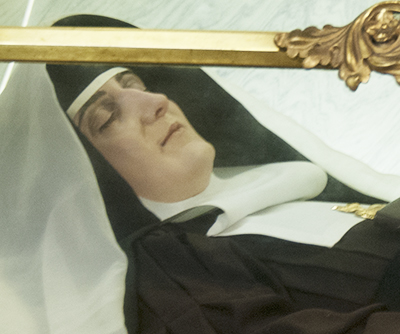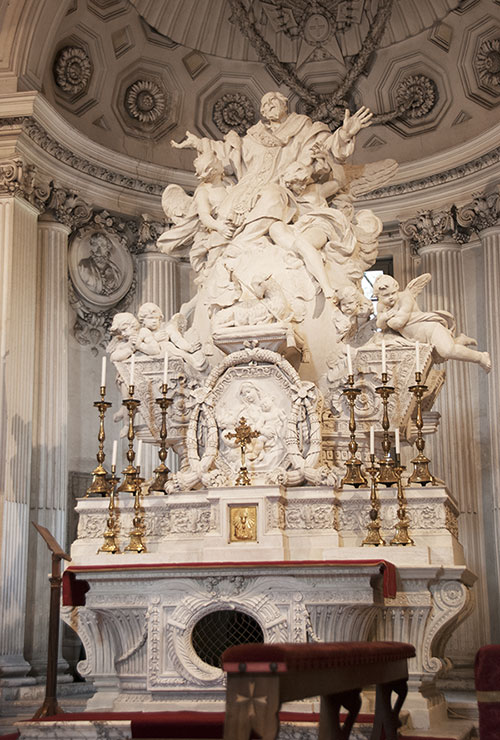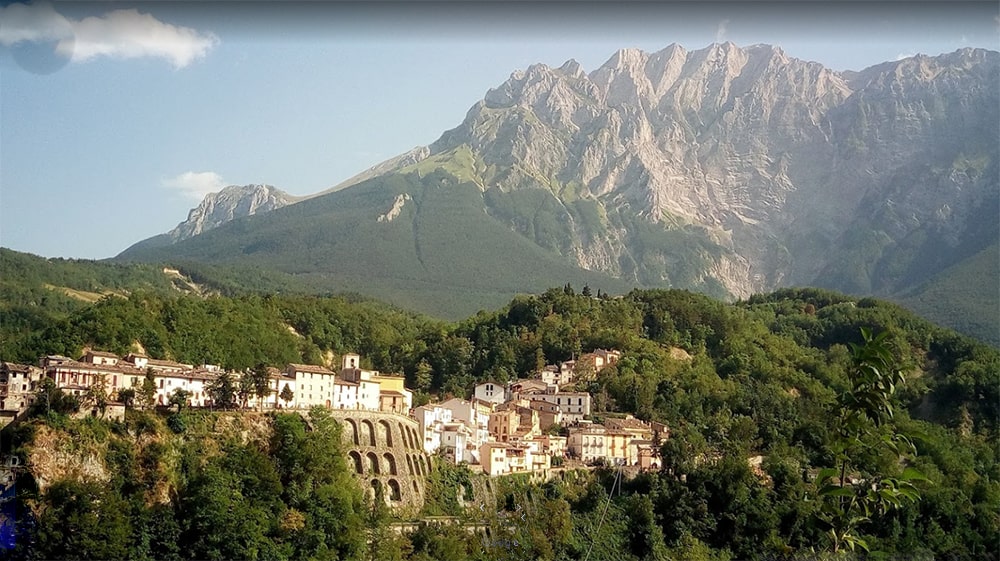Before we get to this incorrupt saint in Rome, I must say that I had decided, no more articles on churches for a while. A good blog has variety. Then, I stumbled upon this body that has been laying around for about 90 years not decomposing …
So, I investigated a little more, and found even more astonishing things. From an agreement to not write about a church, I am writing perhaps the longest article on a church … but, it’s worth it. Remember, click on any of these little pictures for a larger version.

The Sacro Cuore di Gesù is one of several churches in Rome dedicated to the Sacred Heart devotion.
Mostly overlooked by tour books, it is actually quite astounding on several levels.
1st – The Architect

Constructed for the Handmaids of the Sacro Cuore di Gesù, the architect was Aristide Leonori. He today is a world renown architect, working exclusively on religious structures. In Rome, he designed a side chapel in Sant’Andrea della Valle, and the San Patrizio church (the Irish National church, 1892). Aristide built the Santa Croce church in Via Flaminia in 1912 for Pope Pius X. In the style of a “Roman basilica”, it was created to celebrate the 1,600 anniversary of the Edict of Milan. He also intervened in several other churches in Rome.
Outside of Rome, he also designed the Church of St. Joseph in Cairo, Egypt, in 1909, and he restored the church of St. Catherine of Alexandria, Egypt. Also, the Franciscan Monastery of the Holy Land in Washington, D.C., and he contributed to the construction of several other churches in the US. He also worked in Sudan, Buenos Aires, Peru, Australia and New Zealand. London, Ireland, Prague and Warsaw also have thrones and altars designed by Aristide. He was prolific!
The Church

The design of the church is a charming neo-Gothic, complete with a matroneum!
Matronea were intended for women, who were considered 2nd class citizens in Ancient Rome. It developed into the exclusive area for kings, princes and other notable persons who did not want to distract others by their presence in the church.
The only other church in Rome with a matroneum is the ancient church of St. Agnes Fuori della Mura (outside the walls).
The stained glass in clerestory windows were created in “Monaco of Bavaria”, in München, Germany. They represent saints whose names are also the architect’s own family names. These are special because we find very little stained glass in Rome, and these are especially good quality. By the altar, the stained glass represents scenes having to do with the Real Presence.
By the way, all the color decoration on the walls isn’t painting – it is mosaic.

Pietro Gabrini is responsible for all the oil paintings in the church. Before painting here, in 1892, he received a gold medal in Chicago for his painting of Christopher Columbus. His paintings here are no great artistic feat.
All these side chapels reflect the common elements among Sacred Heart religious communities. We see French influence, because the Sacred Heart devotion began with St. Margaret Mary Alacoque. Ignatian Spirituality is also present, because of their missionary activity and devotion to the Holy Eucharist.
Left side (from the entrance): The Death of St. Francis Xavier (missionary Jesuit), The Holy Family, The Annunciation and the Crucifixion of Christ.

St. Anthony who raises the dead, Our Lady of the Pillar with San Giacomo (Spanish), St. John Berchmans with San Luigi Gonzaga and St. Stanislaus Kostka (Jesuits) and St. Rafaela Maria de Porras. Striking is the fact that St. Anthony is usually depicted holding the infant Jesus …
St. Anthony is placed across from the painting of the death of St. Francis Xavier, so what we have depicted here are both death and resurrection themes at the entrance of the church.
The Incorrupt St. Rafaela Maria de Porras Ayllón

The youngest of 9 children, her and her older sister Dolores joined a religious order in Cordoba, Spain but left in 1877. Rafaela formed the Handmaids of the Sacred Heart in Madrid. This order is dedicated to the education of children and the poor. The first mother superior, she also had a board of four advisors – nuns from the community. They however, did nothing but get in the way of the healthy running of the community. The sisters didn’t understand Canon Law or their role as advisors. They believed that they were better administrators than Mother Rafaela. Completely disobedient to her as superior, Rafaela compared them to four nails with which she was nailed to the cross.
She wrote, “There is no offence on their part. They were placed there, just like the nails in the Crucifix of Jesus, by the will of the Eternal Father. I must live willingly nailed by them.”
She forgave them regardless of the trouble they caused, but after six years of this struggle she resigned as mother superior. At the age of 43 she ceased to have any part in the governing of the order which she had founded. She believed it was her duty to be silent, to pray and to suffer.
The new mother superior did not want the real story as to why Sr. Rafaela resigned to get out to the community or the public. So, they banished her to a far-away house of the order – they banished her to Rome.
This might help illustrate how bad were their management skills.

She wasn’t given any official job at her new location, and those four advisors continued to spread rumors about her. They said, among other things that she was mentally incompetent.
Thirteen years after her resignation, she was allowed to visit some of the houses in Spain. The sisters there received her with much joy and love, causing the jealousy of the mother superior. Sr. Rafaela’s visits were cancelled, she was sent back to Rome. She was never allowed to return to Spain again – not even upon the death of her sister, Dolores. Some had even forgotten who was the original founder of the order, Dolores received the credit, while her cohorts continued to say that Rafaela was deranged.
Rafaela suffered these outrageous injustices for over 30 years, practicing forgiveness. “They know not what they do.”
Rafaela died and was buried in 1925, with the sisters in Rome not knowing that she was their founder.
Towards the end of World War II (July 16, 1943), American bombs hit the cemetery where Mother Rafaela was buried (Campo Verano). During the cleaning up and re-arranging of things, her tomb was found preserved and was opened. Her body was found to be incorrupt and flexible, as if she was sleeping.
That caused a few people to get a little curious as to who really was this sister.
Named Venerable May 13, 1949 Pius XII; Beatified May 18, 1952, Pius XII; Canonized Jan 23, 1977, Paul VI, in recognition of her Heroic Virtue.
How to find this church? Simply find “La Romana” – one of the most highly regarded gelateria in Rome. The church is behind it, on via Pavia.
I aim to satisfy all your needs: spiritual, supernatural and carnal!



